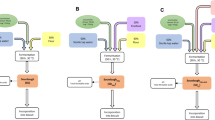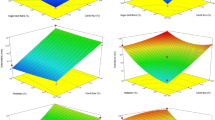Abstract
The consumption of sugar-reduced bakery products represents a promising way to decrease health problems such as obesity, which can be related to the increased intake of added sugar. One highly consumed food product are burger buns, which can contain up to 120 g kg−1 sugar. This study evaluates the impact of sugar-reduction on the quality of burger buns and their respective doughs from a fundamental perspective. Sucrose was replaced by wheat starch in 10 g kg−1 steps and compared to a control burger bun (100 g kg−1). A 30%-sugar-reduction increased gas formation during fermentation, which resulted in a higher specific volume (3.85 ± 0.08 ml/g) when compared to the full-sugar product (3.52 ± 0.07 ml/g). The gluten network developed faster when no sucrose was added (−66 s). It also became stronger (+11 BU) causing a decrease in dough extensibility. Sugar-reduction led to a lighter crust and higher water activity [0.915 ± 0.006 (full-sugar), 0.948 ± 0.004 (no-added sugar)], which shortened shelf life by 6 days. Sugar-reduction is highly correlated to dough characteristics, which result in quality changes of the dough as well as product quality parameter. PCA analysis of the data revealed that the addition of 70 g kg−1 sucrose is essential to ensure adequate burger bun quality.



Similar content being viewed by others
References
Cauvain SP, Young LS (2007) Technology of breadmaking. Springer Science & Business Media, New York
WHO (2015) Media centre WHO calls on countries to reduce sugars intake among adults and children
Gelinas P (2006) Yeast. In: Hui YH (ed) Bak. Prod. Sci. Technol. Blackwell, Ames, pp 173–192
Bean MM, Yamazaki WT (1978) Wheat starch gelatinization in sugar solutions. I. Sucrose: microscopy and Viscosity effects. Cereal Chem 55:936–944
Kim CS, Walker CE (1992) Effects of sugars and emulsifiers on starch gelatinization evaluated by differential scanning calorimetry. Cereal Chem 69:212–217
Perego P, Sordi A, Guastalli R, Converti A (2007) Effects of changes in ingredient composition on the rheological properties of a biscuit industry dough. Int J Food Sci Technol 42:649–657
Davis EA (1995) Functionality of sugars: physicochemical interactions in foods. Am J Clin Nutr 62:170S–177S
Hager AS, Ryan LAM, Schwab C et al (2011) Influence of the soluble fibres inulin and oat β-glucan on quality of dough and bread. Eur Food Res Technol 232:405–413
Jekle M, Becker T (2011) Dough microstructure: novel analysis by quantification using confocal laser scanning microscopy. Food Res Int 44:984–991
Dal Bello F, Clarke CI, Ryan LAM et al (2007) Improvement of the quality and shelf life of wheat bread by fermentation with the antifungal strain Lactobacillus plantarum FST 1.7. J Cereal Sci 45:309–318. doi:10.1016/j.jcs.2006.09.004
Attfield PV (1997) Stress tolerance: the key to effective strains of industrial baker’s yeast. Nat Biotechnol 15:1351–1357
Huang W, Kim Y, Li X, Rayas-Duarte P (2008) Rheofermentometer parameters and bread specific volume of frozen sweet dough influenced by ingredients and dough mixing temperature. J Cereal Sci 48:639–646
Hohmann S, Mager WH (2007) Yeast stress responses. Springer Science & Business Media, Berlin
Pareyt B, Brijs K, Delcour JA (2009) Sugar-Snap cookie dough setting: the impact of sucrose on gluten functionality. J Agric Food Chem 57:7814–7818
Baxter EJ, Hester EE (1958) The effect of sucrose on gluten development and the solubility of the proteins of a soft wheat flour. Cereal Chem 35:366–374
Bordes J, Branlard G, Oury FX et al (2008) Agronomic characteristics, grain quality and flour rheology of 372 bread wheats in a worldwide core collection. J Cereal Sci 48:569–579
Savitha YS, Indrani D, Prakash J (2008) Effect of replacement of sugar with sucralose and maltodextrin on rheological characteristics of wheat flour dough and quality of soft dough biscuits. J Texture Stud 39:605–616
D’Appolonia BL, Morad MM (1981) Bread Staling. Cereal Chem 58:186–190
Yamazaki WT, Kissell LT (1978) Cake flour and baking research: a review. Cereal Foods World 23
Esteller MS, De Lima ACO, Da Silva Lannes SC (2006) Color measurement in hamburger buns with fat and sugar replacers. LWT—Food Sci Technol 39:184–187
Hashiba H (1982) The browning reaction of amadori compounds derived from various sugars. Agric Biol Chem 46:547–548
Cauvain SP, Young LS (2008) Bakery food manufacture and quality: water control and effects. Wiley-Blackwell, Oxford
Mathlouthi M (2001) Water content, water activity, water structure and the stability of foodstuffs. Food Control 12:409–417
Purves D, Augustine GJ, Fitzpatrick D et al (2001) Taste perception in humans. Neurosci. 2nd Ed
Drewnowski A (1987) Sweetness and Obesity. In: Dobbing J (ed) Sweetness. Springer London, London, pp 177–192
Acknowledgement
This work was supported by the Irish Department of Agriculture, Food and the Marine under the Food Institutional Research Measure (F.I.R.M.), project code 14/F/803. The authors want to thank Mr. Tom Hannon for his technical support.
Author information
Authors and Affiliations
Corresponding author
Ethics declarations
Conflict of interest
The authors declare that they have no conflict of interest.
Ethics requirements
This article does not contain any studies with human or animal subjects.
Rights and permissions
About this article
Cite this article
Sahin, A.W., Axel, C. & Arendt, E.K. Understanding the function of sugar in burger buns: a fundamental study. Eur Food Res Technol 243, 1905–1915 (2017). https://doi.org/10.1007/s00217-017-2895-1
Received:
Accepted:
Published:
Issue Date:
DOI: https://doi.org/10.1007/s00217-017-2895-1




